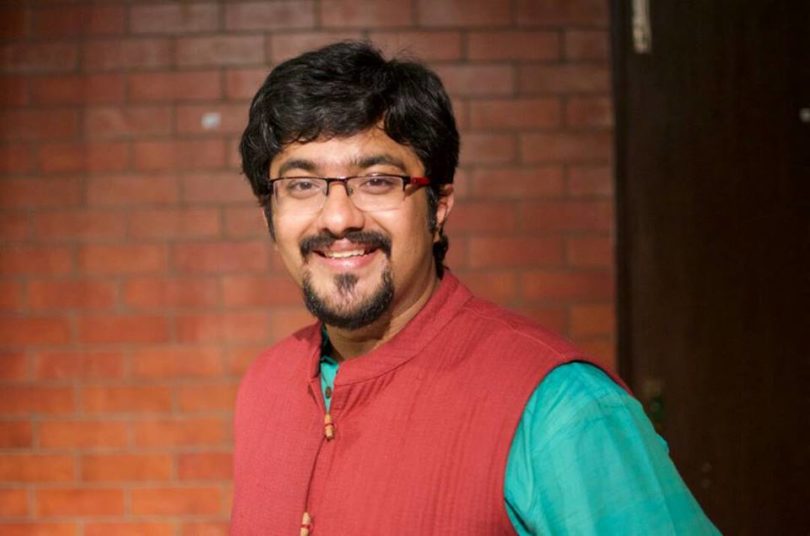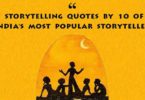Storytelling is a profession driven by passion – the passion of storytellers in their love for stories. There is nothing blue-collared about this profession (even though blue-collared people unknowingly do use it), there is no corporate hierarchy to be followed, no protocols. There is simply the love for stories and the love for seeing an audience that is in tune with the storyteller’s thoughts. Over the years, storytelling has evolved from being a weekend activity for your child at a neighborhood Aunty’s place, to a stable career option for many.
Vikram Sridhar has been an integral part of the storytelling revolution in India. A firm believer in breaking stereotypes in stories and storytelling, and challenging the current form of storytelling, Vikram has been a mentor, a steady to source of knowledge, inspiration and champion for storytelling ventures around the country. He is one of the Founding Members of Bangalore Storytelling Society.
Here are some of his thoughts in his own words.
Stories need to be told because there is a need to be heard. But there is something more…
Stories exist because there are two people involved – the storyteller and the listener. Since time immemorial, the tradition of storytelling has been passed on from senior generation to the younger ones.
It must be noted that the essence of stories does not change; it grows along the journey, in terms of a connection between the teller and listener. This growth can be in various ways – it could be through their understanding of the characters and the situations, the emotional connect, and their application in life. It is important to note that the same stories have been viewed through different perspectives at different stages of life.
The core objective of storytelling is for us to connect with each other in various ways – spiritual bonding, emotional bonding, and also being one with nature.
The importance of the storyteller’s power of visualization while narrating stories
Storytelling is predominantly an oral process. In order to make it more appealing, we usually combine one form with the other to reach out to the larger part of the audience. Along with this, it is also important to understand the absorbing ability of your audience. This varies from one category to the other. Children tend to be more free spirited and imaginative than adults.
While visualizing the story in one’s mind, the storyteller has to first evaluate the ability of the listener to grasp the content of the story, be it audio or in the visual forms. Music is basically an audio process, whereas dance or movies are a mix of both audio and visual aids.
Apart from the type of audience, the proportion of each element – the audio and visual aids – vary with themes, making the overall process of storytelling more effective and appealing. No matter what you choose to aid your narrative, it is but the essence of the stories that you convey that matters the most.
Finding ourselves through stories from the past in today’s fast-paced life
Take the popular story of the Hare and the Tortoise. The moral of the story as we all know – ‘Slow and steady wins the race’. When you look beyond the story, there is an understanding of the pace of the two species.
Most of us are like that hare – constantly running a race. But, the tortoise is more balanced and is associated to being knowledgeable. The story in a bigger sense is a behavioral study which appeals to everyone, including me.
In a deeper philosophical sense, what is a race exactly and why does it even exists?
We all have choices in life. To quote you a word from Assamese, Lahe Lahe asks us to be free-spirited and be self-willing about what we like to do, not worrying about the opinions from others. If you apply this concept to life, then you can enjoy all those moments which can be value-additions to life.
Stories do not need to explicitly tell you all these – the values are forever inherent in them. That is the power of stories and their contribution to life. For a child, the story could just be a narrative of a race. But, for an adult it could mean a lot more beyond just a story in a deeper sense.
There are thousands of stories in various languages, dialects and genres. Yet storytelling as a profession and the awareness surrounding it, is limited to a handful of cities in India. Spreading the net of storytelling across the length and breadth of the country is a necessity.
Cultural identity is important as it reflects the local histories and it is really important to be preserved for times ahead. In this aspect, stories are great ways of documenting people’s lives and thereby the history.
Family stories are passed on through generations, keeping alive the richness of the legacy that later becomes a part of one’s cultural identity.
Language plays a vital role in conveying our ideas and spreading the essence of the stories. Most storytellers use English as a medium for storytelling, but it is equally important to uphold the stories told in vernacular languages. I believe, we all must embrace at least three languages – English, because it is a work necessity, Hindi as majority of people in our country speak that language and one vernacular language that is a native identity of an individual. This makes it easier and far more effective in keeping the spirit of storytelling alive in times to come by.
In today’s era where we are surrounded by gadgets and technology, we hardly have time for others, even our family members. Thus, we lose the overall connect with people. Stories are a great way to revive that lost bonding.
Bangalore Storytelling Society and Its Contribution to Keeping Stories Alive
The Bangalore Storytelling Society hosts monthly meetups where people come to share stories. The idea is to encourage the storyteller within each person to rear its head. Every month has a flavor and we at BSS, explore those flavors in the form of themes. BSS hosts two events every month – Meetup, which is exclusively for adult participants and Heads and Tales, which focuses on creating a platform where families and children can be a part of the performance.
Basically, the themes or concepts are decided keeping the current season or month in mind. For instance, Mango is the popular flavor of summer season and the theme of our summer event revolved around that fruit! These themes are decided through discussions and brainstorming sessions. Apart from specific themes, we also bring out random topics that range from flavors of the seasons to gadgets and emotions. These themes have been very well portrayed in lots of stories, told across ages and time-zones.
—
Don’t forget to catch the second part of Vikram’s interview on “Storytelling in Boardrooms” next Monday.
—
Vikram Sridhar is a Founding Member at Bangalore Storytelling Society, Founding Member at The BeSt Festival: The Bengaluru Storytelling Festival and Co-founder at theater group Tahatto.
—
This article is a part of our #MondayColumns on #Storytelling. Interview compiled with inputs from Vikram Sirdhar. If you wish to contribute to this column, write in to editor@tell-a-tale.com.





